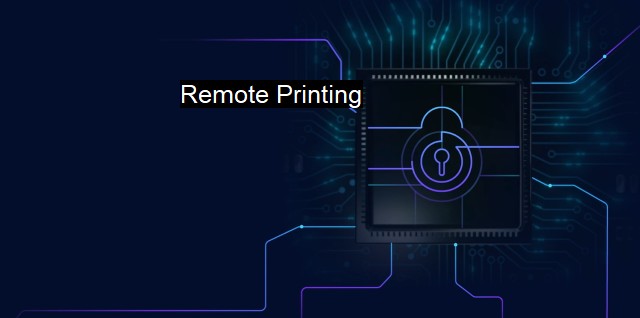What is Remote Printing?
Securing Remote Printing: How to Safeguard Business Print Operations in the Digital Age
Remote Printing refers to the phenomenon of printing documents within a shared network from any location, via devices such as laptops, smartphones, or tablets, on a printer that is not locally connected to these devices. This modern technical feature is extraordinarily beneficial, primarily for professional establishments that require efficient, accessible, and mobile solutions to perform their operations. it also necessitates rigorous cybersecurity measures, as it potentially interests cybercriminals, making it a target for various cyber threat vectors.With the rising trends of remote work and flexible office environments, remote printing has indeed revolutionized the conventional concept of printing. Whereas users previously had to physically connect their devices to a specific printer to print documents, these constraints are no longer relevant. The flexibility of printing documents remotely, either within the office or from home, without being connected to a particular printer, benefits firms aiming for operational efficacy.
The inherent nature of remote printing also opens up a plethora of cybersecurity risks. Like all devices interconnected on a network, printers are susceptible to cyber threats, this vulnerability gets amplified in the case of remote printing because of the open network connections utilized. Cybercriminals can intercept the network connection to gain unauthorized access to print jobs, make unauthorized changes, or even deploy malware or ransomware into the systems. The downloaded data can be manipulated, leading to significant data leaks, financial loss, and a compromised reputation for businesses.
Undoubtedly, data in transit during the remote printing process can be an easy target for spoilers if it is not encrypted. Encrypted data adds a solid layer of protection as it converts the information into an unreadable format, allowing only authorized entities with the decryption key to access it. Therefore, companies must deploy professional-grade encryption software and other stringent cybersecurity measures to safeguard against these risks.
Beyond encryption, another fundamental measure ensuring the secure printing of documents remotely, is adopting a robust antivirus solution. Modern printers often feature in-built software, which can antagonize several threat vectors. But, these may not suffice invariably. Up-to-date, comprehensive antivirus software can act effectively against common network risks, including trojans, worms, ransomware, and spyware, among others, thereby providing a secure printing environment. These antivirus applications detect and neutralize threats before they infiltrate the network, thus maintaining systems' integrity.
Two-factor authentication (2FA) can be an additional layer of protection in the process of remote printing. Using a combination of two different components or 'factors' (something you know-password, and something you possess-mobile device), it safeguards from unauthorized access to network printers. This makes it significantly harder for attackers to gain entry by guessing or stealing user credentials.
Printer management also plays a critical role in mitigating these cyber threats. Traffic should always be monitored, and printer logs must be checked regularly for any suspicious activity. Maintaining the latest printer firmware and controlling the user access rights can prevent most of the potential vulnerabilities.
Remote Printing is an exceptionally advantageous feature provided by modern technology that brings in effortless accessibility and notably enhances efficiency across workplaces. its utility comes with significant cybersecurity risks, but with vigilance and the right security measures in place, it is entirely possible to enjoy the benefits it offers while minimizing the inherent cyber threats. In an era where cyberattacks are becoming increasingly sophisticated, only a comprehensive multi-layered security approach, involving encryption, antivirus solutions, two-factor authentication, and vigilant printer management, can safeguard remote printing operations effectively.

Remote Printing FAQs
What is remote printing?
Remote printing refers to the ability to print documents from a device that is not physically connected to the printer. It allows users to send print jobs from their remote location to a printer located in a different physical location.Is remote printing safe and secure?
Remote printing can be safe and secure if proper cybersecurity measures are in place. It is important to ensure that the remote printing service is protected by appropriate antivirus and firewall software to prevent unauthorized access and data breaches.What are some risks associated with remote printing?
One of the main risks associated with remote printing is that there is always a chance of data interception or theft during the process. Hackers may try to intercept the print job and steal sensitive information such as usernames, passwords, and other confidential data.How can I protect my data when using remote printing?
To protect your data when using remote printing, it is important to use a secure and encrypted connection. Additionally, ensure that only authorized personnel have access to the remote printing service and that all devices used for the process are protected with updated antivirus software.| | A | | | B | | | C | | | D | | | E | | | F | | | G | | | H | | | I | | | J | | | K | | | L | | | M | |
| | N | | | O | | | P | | | Q | | | R | | | S | | | T | | | U | | | V | | | W | | | X | | | Y | | | Z | |
| | 1 | | | 2 | | | 3 | | | 4 | | | 7 | | | 8 | | |||||||